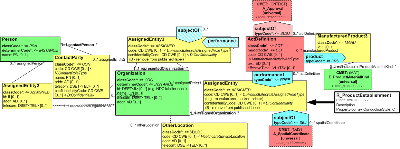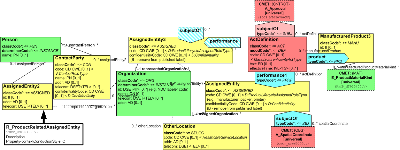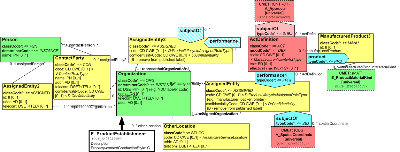 HL7 CCPM, R1 HL7 Version 3 Standard: Common Product Model CMETs, DSTU Release 11 June 2011 |
Content Last Edited: 2011-06-14T14:26:17
Organizations that handle products, manufacturers, parts suppliers, distributors, testers, importers, etc.
|
||||||||||
|
For details on the interpretation of this section, see the description of RMIMs in the Version 3 Guide.

| Parent: | ProductKind (POCP_DM010000UV) |
Links an establishment to the main organization. Such establishment may be a manufacturing facility, subsidiary, contractor, or other business partner. Notice this AssignedEntity role is configured such that hierarchies of related organizations can be expressed.
| R_ProductEstablishment | POCP_HD030300UV01 |

| Parent: | ProductKind (POCP_DM010000UV) |
A combination of a persons and/or organization involved in the product life cycle in some way (e.g., creation and review of a product labeling document, performing a testing activity).
This is the primary role used to connect to any actual activities when the action performed are in the real world ultimately executed by individuals whether these individuals are of particular interest or not. It is perfectly acceptable not to specify the person (or the organization) if that is not required, however, if this structure is used to connect to activities rather than one that only considers the Organization as a player, because in advanced use cases (where tracking and individual authority must be traceable) it is important to have the ability to specify a distinguishable individual person. The way in which a Person and Organization is participating in the product life-cycle is specified by the typeCode attribute on the relevant participation and associated act. While the nature of the participation may be suggested by the XML element name, the typeCode values are the definitive indication.
| R_ProductRelatedAssignedEntity | POCP_HD030100UV01 |

| Parent: | ProductKind (POCP_DM010000UV) |
Any organization that plays a role in the product life-cycle in any way. The role that this organization plays and how it performs with regards to other organizations and the product is specified by the relationships (roles, participations) with other organizations and acts respectively.
| E_ProductEstablishment | POCP_HD030200UV01 |
|
||||||||||
|
For details on the interpretation of this section, see the description of HMDs in the Version 3 Guide.
Links an establishment to the main organization. Such establishment may be a manufacturing facility, subsidiary, contractor, or other business partner. Notice this AssignedEntity role is configured such that hierarchies of related organizations can be expressed.
| A_SpatialCoordinateUniversal | COCT_MT960000UV05 |
| E_ProductMaterialKindUniversal | POCP_MT010400UV01 |
| A_ApprovalUniversal | POCP_MT050700UV01 |
| R_ProductEstablishment | POCP_MT030300UV01 |
A combination of a persons and/or organization involved in the product life cycle in some way (e.g., creation and review of a product labeling document, performing a testing activity).
This is the primary role used to connect to any actual activities when the action performed are in the real world ultimately executed by individuals whether these individuals are of particular interest or not. It is perfectly acceptable not to specify the person (or the organization) if that is not required, however, if this structure is used to connect to activities rather than one that only considers the Organization as a player, because in advanced use cases (where tracking and individual authority must be traceable) it is important to have the ability to specify a distinguishable individual person. The way in which a Person and Organization is participating in the product life-cycle is specified by the typeCode attribute on the relevant participation and associated act. While the nature of the participation may be suggested by the XML element name, the typeCode values are the definitive indication.
| A_SpatialCoordinateUniversal | COCT_MT960000UV05 |
| E_ProductMaterialKindUniversal | POCP_MT010400UV01 |
| A_ApprovalUniversal | POCP_MT050700UV01 |
| R_ProductRelatedAssignedEntity | POCP_MT030100UV01 |
Any organization that plays a role in the product life-cycle in any way. The role that this organization plays and how it performs with regards to other organizations and the product is specified by the relationships (roles, participations) with other organizations and acts respectively.
| A_SpatialCoordinateUniversal | COCT_MT960000UV05 |
| E_ProductMaterialKindUniversal | POCP_MT010400UV01 |
| A_ApprovalUniversal | POCP_MT050700UV01 |
| E_ProductEstablishment | POCP_MT030200UV01 |
| Return to top of page |

